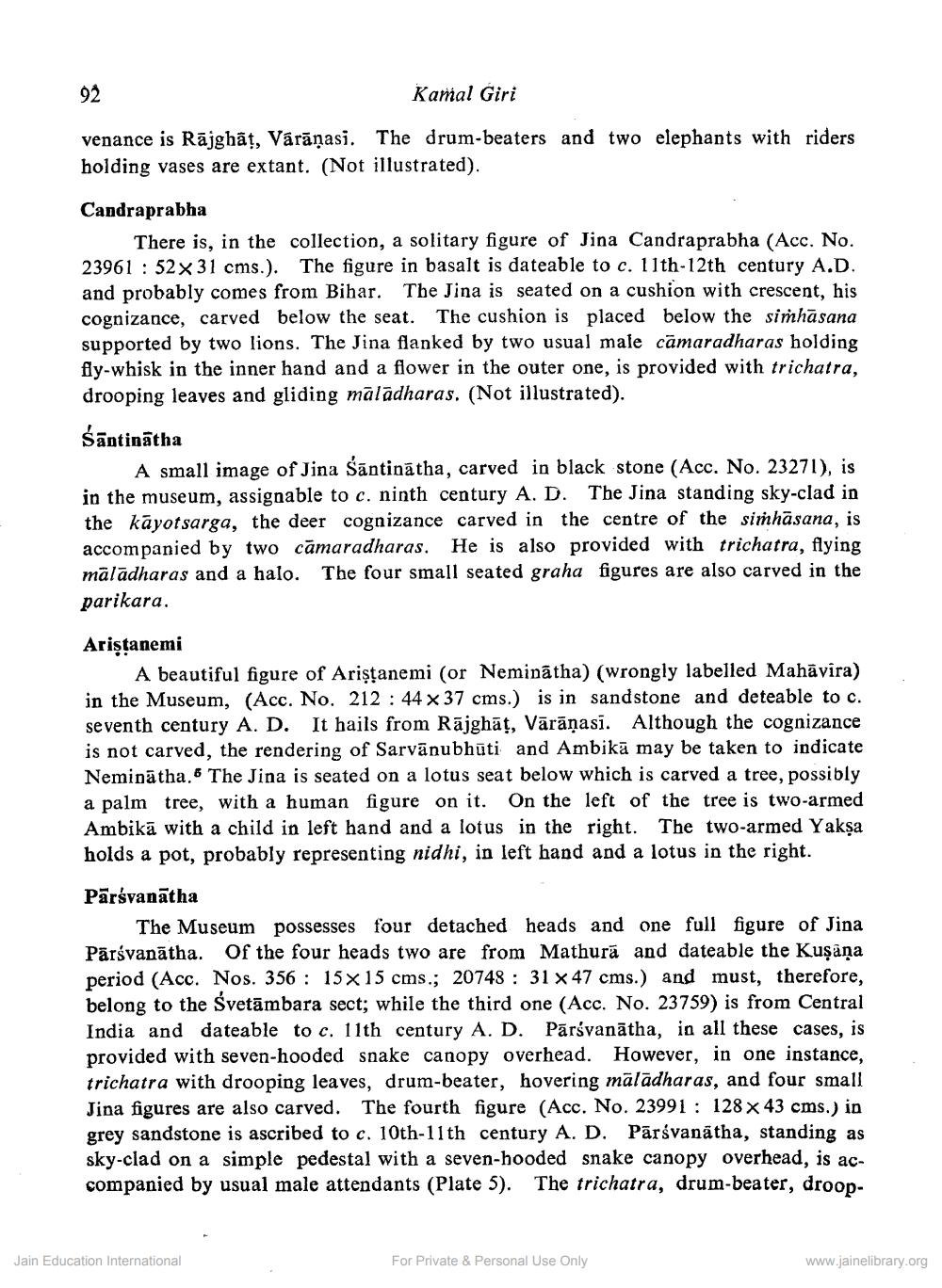Book Title: Jaina Sculptures in Bharata Kala Bhavan Author(s): Kamalgiri Publisher: Z_Aspect_of_Jainology_Part_2_Pundit_Bechardas_Doshi_012016.pdf View full book textPage 4
________________ 92 Kamal Giri venance is Rājghāt, Várāṇasi. The drum-beaters and two elephants with riders holding vases are extant. (Not illustrated). Candraprabha There is, in the collection, a solitary figure of Jina Candraprabha (Acc. No. 23961 : 52 x 31 cms.). The figure in basalt is dateable to c. 11th-12th century A.D. and probably comes from Bihar. The Jina is seated on a cushion with crescent, his cognizance, carved below the seat. The cushion is placed below the simhasana supported by two lions. The Jina flanked by two usual male câmaradharas holding fly-whisk in the inner hand and a flower in the outer one, is provided with trichatra, drooping leaves and gliding malādharas. (Not illustrated). Santinātha A small image of Jina Šāntinātha, carved in black stone (Acc. No. 23271), is in the museum, assignable to c. ninth century A. D. The Jina standing sky-clad in the kāyotsarga, the deer cognizance carved in the centre of the simhāsana, is accompanied by two camaradharas. He is also provided with trichatra, flying mālādharas and a halo. The four small seated graha figures are also carved in the parikara. Aristanemi A beautiful figure of Ariştanemi (or Neminātha) (wrongly labelled Mahāvira) in the Museum, (Acc. No. 212 : 44 x 37 cms.) is in sandstone and deteable to c. seventh century A. D. It hails from Rājghāt, Vārāṇasī. Although the cognizance is not carved, the rendering of Sarvānubhūti and Ambikā may be taken to indicate Neminātha 6 The Jina is seated on a lotus seat below which is carved a tree, possibly a palm tree, with a human figure on it. On the left of the tree is two-armed Ambikā with a child in left hand and a lotus in the right. The two-armed Yakşa holds a pot, probably representing nidhi, in left hand and a lotus in the right. Pārsvanātha The Museum possesses four detached heads and one full figure of Jina Pārsvanātha. Of the four heads two are from Mathurā and dateable the Kuşāņa period (Acc. Nos. 356 : 15 x 15 cms.; 20748 : 31 x 47 cms.) and must, therefore, belong to the Svetāmbara sect; while the third one (Acc. No. 23759) is from Central India and dateable to c. 11th century A. D. Pārsvanātha, in all these cases, is provided with seven-hooded snake canopy overhead. However, in one instance, trichatra with drooping leaves, drum-beater, hovering mālādharas, and four small Jina figures are also carved. The fourth figure (Acc. No. 23991 : 128 x 43 cms.) in grey sandstone is ascribed to c. 10th-11th century A. D. Pārsvanátha, standing as sky-clad on a simple pedestal with a seven-hooded snake canopy overhead, is accompanied by usual male attendants (Plate 5). The trichatra, drum-beater, droop Jain Education International For Private & Personal Use Only www.jainelibrary.orgPage Navigation
1 2 3 4 5 6 7 8 9 10 11 12 13 14 15
